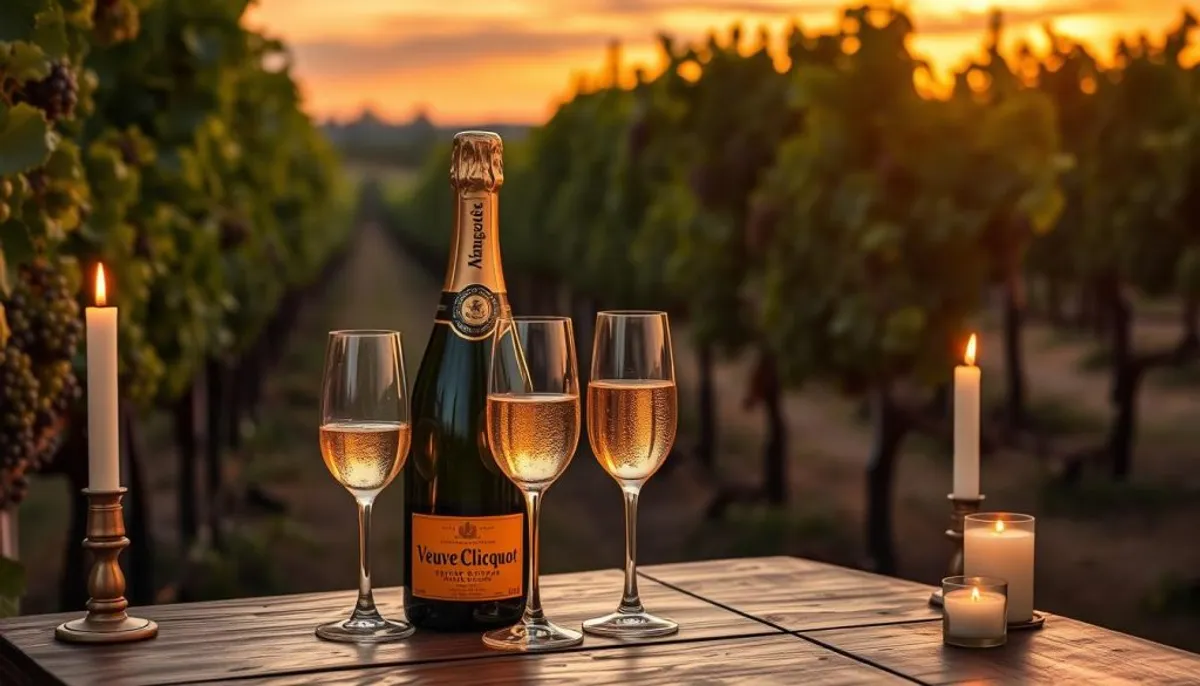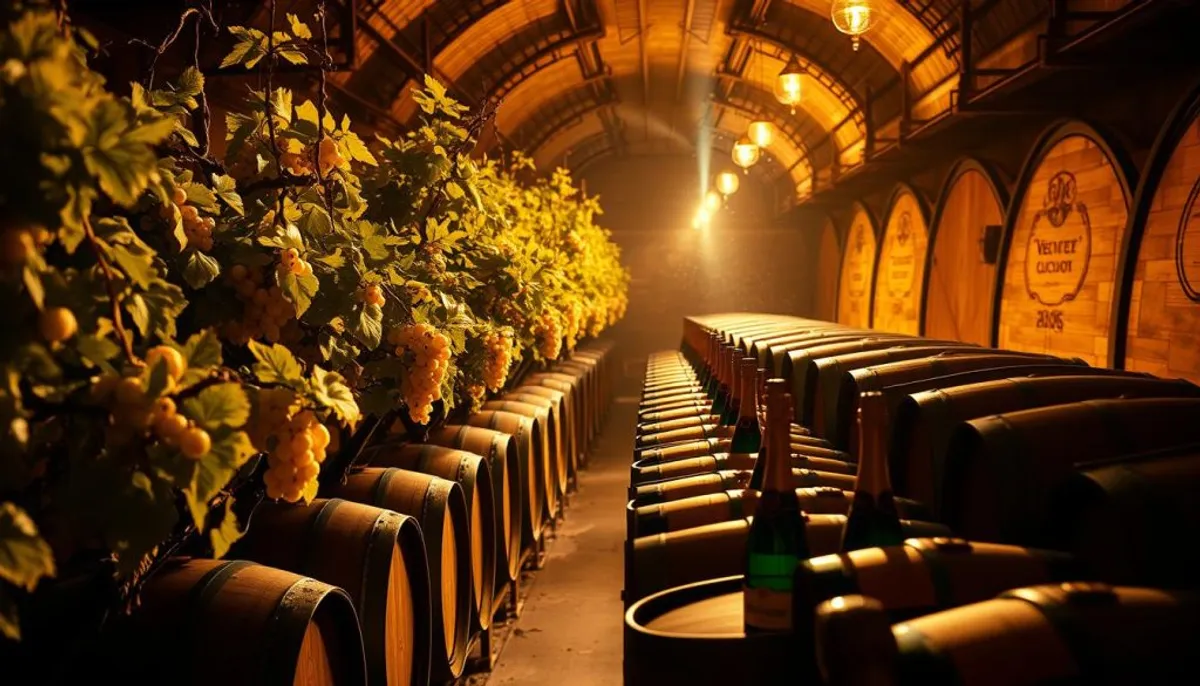Delve into the realm of French wine and luxury beverages as we explore the extraordinary tale of Veuve Clicquot. This renowned Champagne house’s triumph is attributed to a pioneering woman who transformed the industry. Born in 1777, Barbe-Nicole Clicquot Ponsardin elevated a modest family venture into a global Champagne powerhouse.

At just 27, Madame Clicquot found herself a widow, yet she seized the reins of her father-in-law’s enterprise. Her forward-thinking led to significant breakthroughs in Champagne production, earning her the nickname “la grande dame of Champagne.” Her achievements, from pioneering the first vintage Champagne to inventing the riddling table, have indelibly marked the trajectory of this effervescent drink.
Veuve Clicquot’s influence on Champagne’s history transcends its iconic yellow label. Madame Clicquot’s legacy is a testament to her ingenuity, business prowess, and the high standards she set for the brand. Today, Veuve Clicquot stands as a symbol of one woman’s unwavering resolve and vision in the realm of luxury beverages.
Key Takeaways
- Barbe-Nicole Clicquot Ponsardin became a widow at 27 and took charge of the family Champagne business
- She invented the riddling table, revolutionizing Champagne production
- Veuve Clicquot created the first vintage Champagne and blended rosé Champagne
- The brand’s iconic yellow label is recognized worldwide
- Madame Clicquot’s innovations shaped modern Champagne-making techniques
- Veuve Clicquot remains one of the top-selling Champagne brands globally
- Her story continues to inspire, with recent adaptations in music and film
The Rise of a Champagne Dynasty: Barbe-Nicole Ponsardin’s Early Life
Barbe-Nicole Ponsardin was born on December 16, 1777, in Reims, France. She was a member of the esteemed Ponsardin family, renowned for their significant role in the textile industry. Her early years were characterized by privilege and opportunity, laying the groundwork for her future as a pioneering businesswoman, which would eventually lead to her association with ldi champagne.
Born into Textile Nobility in Reims
The Ponsardin family held a distinguished position in Reims. They owned the city’s largest textile factory, which was the cornerstone of their wealth and influence. This industrial powerhouse played a crucial role in shaping Barbe-Nicole’s understanding of business and commerce from a young age.
The Influential Ponsardin Family Legacy
Beyond their textile empire, the Ponsardin family was deeply involved in the civic life of Reims. Barbe-Nicole’s father, Nicolas Ponsardin, served as the city’s mayor, further cementing their status. This political connection exposed young Barbe-Nicole to the intricacies of leadership and social responsibility.
Marriage to François Clicquot
In the late 18th century, Barbe-Nicole’s life took a pivotal turn when she married François Clicquot. Her husband came from a family of vintners, introducing her to the world of Champagne production. This union would prove to be the foundation of her future legacy in the Champagne industry.
| Event | Date | Significance |
|---|---|---|
| Birth of Barbe-Nicole Ponsardin | December 16, 1777 | Born into Reims textile nobility |
| Marriage to François Clicquot | Late 18th century | Introduction to Champagne industry |
| Death of François Clicquot | 1805 | Barbe-Nicole becomes a widow at 27 |
From Tragedy to Triumph: Becoming Veuve Clicquot
In the 19th century, women entrepreneurs were a rare sight. Barbe-Nicole Ponsardin’s journey from tragedy to triumph reshaped the champagne industry. Her story is one of resilience and innovation, earning her the title of Veuve Clicquot.
Widowed at Twenty-Seven
Barbe-Nicole’s life was forever altered when her husband, François Clicquot, passed away. At 27, she was left a widow, managing a vineyard. This was a monumental task, given the societal constraints of the time.
Taking Control of the Family Business
Barbe-Nicole defied conventions by taking the reins of her family’s champagne business. This bold move made her a pioneering figure in the Napoleonic era. Her leadership was a turning point for the industry.
Breaking Gender Barriers in 19th Century France
In the male-dominated world of 19th century France, Veuve Clicquot faced numerous obstacles. Undeterred, she introduced groundbreaking innovations in champagne production, including her famed veuve clicquot champagne. Her achievements opened doors for future generations of women entrepreneurs, leaving a lasting legacy.
| Achievement | Impact |
|---|---|
| Developed foreign markets | Made Veuve Clicquot one of the best-known champagnes globally |
| Introduced production innovations | Enhanced wine clarity and consistency, still used today |
| Built a loyal sales network | Expanded brand reach throughout the continent |
Revolutionary Innovations in Champagne Making

Barbe-Nicole Clicquot Ponsardin, widowed at 27, transformed the champagne industry with her groundbreaking winemaking techniques. Her innovations in champagne production set new standards for quality and clarity. In 1810, she introduced the first recorded vintage champagne, marking a significant milestone in wine innovation.
The riddling process, invented by Madame Clicquot in 1816, revolutionized champagne making. This technique, known as “remuage,” involves storing bottles upside down to collect sediment in the neck, clarifying the wine. The riddling table, or “table de remuage,” became a game-changer in champagne production, improving product quality and international competitiveness.
Madame Clicquot’s creativity didn’t stop there. In 1818, she created the first rosé champagne by blending red Pinot from Bouzy with champagne. This bold move showcased her willingness to experiment with winemaking techniques, further cementing her reputation as a pioneer in the industry.
These revolutionary innovations not only elevated Veuve Clicquot’s status but also shaped modern champagne production methods. Madame Clicquot’s legacy continues to inspire winemakers worldwide, proving that innovation and quality are the cornerstones of success in the champagne industry.
The Invention of the Riddling Table: A Game-Changing Innovation
The riddling table is a testament to Madame Clicquot’s ingenuity in Champagne production. This revolutionary device transformed the way wine sediment was removed. It led to clearer and more refined Champagne.
The Technical Breakthrough
In 1816, Madame Clicquot invented the riddling table, a pivotal moment in Champagne clarification. This innovation allowed for efficient wine sediment removal. It resulted in a cleaner, more appealing product.
The process involved placing bottles at an angle and gradually rotating them. This caused sediment to collect in the neck for easy extraction.
Impact on Modern Champagne Production
The riddling table revolutionized Champagne making, becoming an industry standard. It significantly improved the clarity and quality of Champagne, including offerings from the renowned bollinger vineyard. This led to increased production and sales.
Veuve Clicquot’s sales skyrocketed from 43,000 bottles in 1816 to 280,000 in 1821. This showcases the innovation’s immediate impact.
| Year | Innovation | Impact |
|---|---|---|
| 1816 | Riddling Table Invention | Improved Champagne clarification |
| 1818 | First Blended Rosé Champagne | New Champagne variety introduced |
| 1821 | Expanded Production | 280,000 bottles sold annually |
The riddling table’s invention marked a turning point in Champagne production. It not only enhanced the drink’s quality but also paved the way for future innovations. Today, modern Champagne makers still rely on this technique, albeit with automated systems, to create the clear, sparkling wine we enjoy.
Marketing Genius: Building the Ponsardin Brand
Madame Clicquot transformed Champagne marketing with groundbreaking strategies. Her approach to Veuve Clicquot branding established new benchmarks in the industry. This paved the way for contemporary marketing practices, and serves as an excellent champagne tasting guide for enthusiasts looking to understand the nuances of branding in the champagne sector.
Creating the Iconic Yellow Label
The yellow label became synonymous with Veuve Clicquot’s identity. This bold choice distinguished the brand from competitors, making it instantly recognizable. The distinctive color cemented Veuve Clicquot’s status as a premium Champagne, attracting discerning consumers globally.
International Market Expansion
Madame Clicquot’s marketing prowess extended beyond branding. She concentrated on international expansion, notably in Russia. By the mid-19th century, Veuve Clicquot-Ponsardin had a significant presence across Europe. This global footprint solidified the brand’s reputation and expanded its market share.
The success of Veuve Clicquot’s marketing strategies is evident in its production figures. Today, La Grande Dame, the brand’s premium offering, accounts for less than 2% of total production. The rosé variant, making up 20% of this exclusive line, underscores the lasting impact of Madame Clicquot’s marketing vision.
The First Vintage and Blended Rosé Champagne
Madame Clicquot, widowed at 27 in 1805, transformed the Champagne industry with her groundbreaking spirit. In 1810, she pioneered the first single-vintage Champagne, establishing a benchmark for excellence. This achievement marked the beginning of a new era in Champagne production, leading to what would be known as the stellar release of her innovative techniques.
Eight years later, Madame Clicquot’s ingenuity led to another milestone. She developed the first blended rosé Champagne, merging still red and sparkling white wines. This method, a departure from the traditional dyeing process, was a revolutionary step forward.
Her innovations had a significant impact. By 1850, Veuve Clicquot’s sales skyrocketed to 400,000 bottles annually. At her death in 1866, sales had nearly doubled to 750,000 bottles, highlighting the lasting appeal of her creations.
Today, Madame Clicquot’s legacy in wine blending continues to influence the industry. The La Grande Dame Rosé, a premium vintage Champagne, exemplifies her enduring impact. Made from Pinot Noir grapes from the Clos Colin vineyard in Bouzy, this rosé is aged for seven years. It can be stored for up to 15 years, demonstrating the lasting quality of her innovative techniques.
Navigating Business During the Napoleonic Era
The Napoleonic Wars presented both hurdles and opportunities for French wine export. Barbe-Nicole Ponsardin, famously known as Veuve Clicquot, seized these challenges head-on. She revolutionized 19th century trade practices in champagne production and distribution, paving the way for sparkling wine tasting experiences that would captivate enthusiasts around the world.
Strategic Trade Relations
Veuve Clicquot’s business acumen was evident during this tumultuous period. She focused on Russian troops, leading to a 250% surge in demand for her champagne. In a daring move, she dispatched 10,500 bottles of her 1811 vintage to Russia. This bold risk paid off spectacularly.
Overcoming Political Challenges
Despite the political turmoil, Veuve Clicquot’s champagne ignited a drinking frenzy in Moscow and St. Petersburg. Czar Alexander declared it his exclusive choice. This strategic maneuver during the Napoleonic Wars cemented Veuve Clicquot’s dominance, securing a 70% market share.
| Business Strategy | Impact |
|---|---|
| Targeting Russian troops | 250% increase in demand |
| Shipping 1811 vintage to Russia | Secured Czar’s exclusive preference |
| Innovative storage technique | 30% increase in revenue |
Veuve Clicquot’s innovative storage technique, placing bottles upside down, significantly boosted revenue by 30%. This method enhanced taste and bubble quality, establishing new benchmarks in champagne production.
The Cultural Impact on Modern Champagne Industry
Madame Clicquot’s legacy profoundly influences Champagne culture and the luxury beverages market. Her groundbreaking innovations transformed the wine industry, shaping production and marketing strategies that endure. The Veuve Clicquot brand, now part of the LVMH group, epitomizes luxury and quality in the Champagne realm.
Barbe-Nicole Ponsardin’s impact transcends her own brand. She set a precedent for other widows, like Louise Pommery and Lily Bollinger, to lead Champagne houses. These pioneers introduced innovations such as brut Champagne and extended lees aging, elevating industry standards.
Veuve Clicquot’s influence on Champagne culture is evident in modern marketing. The iconic yellow label, trademarked in 1877, is a symbol of luxury. The brand’s dedication to innovation is seen in creations like La Grande Dame vintage Champagne, launched in 1972 to celebrate the winery’s bicentenary.
The Veuve Clicquot Business Woman Award, established in 1972, honors Madame Clicquot’s entrepreneurial spirit. By 2012, it was presented in 27 countries, inspiring a new generation of women in business. This award highlights Madame Clicquot’s lasting influence on the Champagne industry and broader business culture.
Preserving the Heritage: Modern Day Veuve Clicquot
Veuve Clicquot today stands as a testament to its rich wine heritage. The brand’s commitment to quality and innovation is evident in its contemporary Champagne production methods. In 2012, Veuve Clicquot Ponsardin became the world’s second-highest selling Champagne brand, with 1,474,000 nine-liter cases sold globally.
Contemporary Production Methods
While honoring tradition, Veuve Clicquot embraces modern techniques. The brand utilizes the iconic chalk quarries, or crayères, of the Champagne region. These UNESCO World Heritage sites provide ideal conditions for fermentation and aging, merging ancient wisdom with current practices, including exclusive wine pairing that enhances the tasting experience.

Maintaining Traditional Values
Veuve Clicquot’s dedication to its roots is evident in its product lineup. The classic Brut Yellow Label, introduced in 1877, remains a symbol of the brand’s vibrant spirit. To celebrate its bicentennial, Veuve Clicquot launched the prestigious vintage La Grande Dame in 1972, paying homage to Madame Clicquot’s legacy.
| Year | Milestone |
|---|---|
| 1810 | Creation of first vintage Champagne |
| 1877 | Introduction of iconic yellow label |
| 1972 | Launch of La Grande Dame |
| 1986 | Acquisition by LVMH |
Under LVMH ownership since 1986, Veuve Clicquot continues to innovate while preserving its heritage. The brand has implemented sustainability initiatives in its vineyards and production facilities, including the use of premium cbd products. This ensures its legacy endures for future generations of Champagne enthusiasts.
Conclusion
Barbe-Nicole Clicquot Ponsardin’s Champagne legacy is a shining example of women’s impact in business. At 28, she became the first woman to helm a Champagne house, opening doors for others. Her groundbreaking innovations, such as the first vintage champagne in 1810 and the riddling rack, transformed the industry.
Her business acumen is evident in Veuve Clicquot’s success. She adapted her wines to Russian tastes, sparking a market boom. In 1818, she introduced the first true rosé Champagne, blending Pinot Noir. These achievements solidified Veuve Clicquot’s status in the luxury wine market.
Veuve Clicquot Ponsardin remains a beacon of excellence in the Champagne world. Founded in 1772, it has evolved into a global brand synonymous with premium wines and champagnes. Barbe-Nicole’s legacy continues to inspire, showing that vision and determination can leave a lasting impact on luxury and business.
RelatedRelated articles



